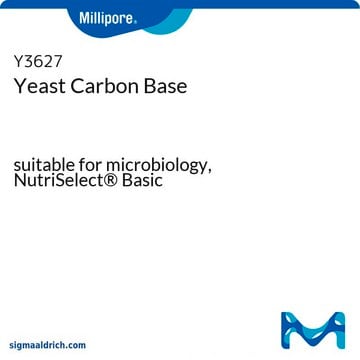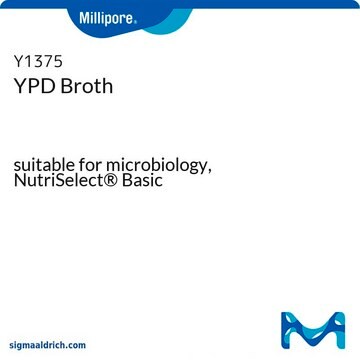Y1251
Yeast Nitrogen Base Without Amino Acids and Ammonium Sulfate
suitable for microbiology, NutriSelect® Basic
Sign Into View Organizational & Contract Pricing
All Photos(1)
About This Item
UNSPSC Code:
41171606
NACRES:
NA.85
Recommended Products
sterility
non-sterile
form
powder
packaging
poly bottle of 1 kg
poly bottle of 500 g
manufacturer/tradename
NutriSelect® Basic
solubility
water: soluble 67 mg/mL
application(s)
clinical testing
food and beverages
life science and biopharma
microbiology
suitability
Candida spp.
Pichia spp.
Saccharomyces spp.
Zygosaccharomyces spp.
molds
yeasts
General description
Yeast Nitrogen Base Without Amino Acids and Ammonium Sulfate is recommended to use for classifying yeasts based on their carbon and nitrogen requirements. The medium contains all essential nutrients required for the growth of yeasts except amino acids, histidine, methionine and tryptophan, and also ammonium sulphate. The addition of nitrogen and carbon sources is required as described in the Manual of Clinical Microbiology
Application
Yeast Nitrogen Base Without Amino Acids and Ammonium Sulfate is used in classifying yeasts based on carbon and nitrogen requirements. It contains all essential nutrients required for the growth of yeasts except amino acids, nitrogen and carbohydrate. The addition of nitrogen and carbon sources is required.
Components
Ingredients
Biotin, 2 μg/L
Calcium pantothenate, 400 μg/L
Folic acid, 2 μg/L
Niacin, 400 μg/L
p-Aminobenzoic acid, 200 μg/L
Pyridoxine HCl, 400 μg/L
Riboflavin, 200 μg/L
Thiamine HCl, 400 μg/L
Inositol, 2 mg/L
Boric acid, 500 μg/L
Copper sulfate, 40 μg/L
Potassium iodide, 100 μg/L
Ferric chloride, 200 μg/L
Manganese sulfate, 400 μg/L
Sodium molybdate, 200 μg/L
Zinc sulfate, 400 μg/L
Potassium phosphate monobasic, 1 g/L
Magnesium sulfate, 0.5 g/L
Sodium chloride, 0.1 g/L
Calcium chloride, 0.1 g/L
Biotin, 2 μg/L
Calcium pantothenate, 400 μg/L
Folic acid, 2 μg/L
Niacin, 400 μg/L
p-Aminobenzoic acid, 200 μg/L
Pyridoxine HCl, 400 μg/L
Riboflavin, 200 μg/L
Thiamine HCl, 400 μg/L
Inositol, 2 mg/L
Boric acid, 500 μg/L
Copper sulfate, 40 μg/L
Potassium iodide, 100 μg/L
Ferric chloride, 200 μg/L
Manganese sulfate, 400 μg/L
Sodium molybdate, 200 μg/L
Zinc sulfate, 400 μg/L
Potassium phosphate monobasic, 1 g/L
Magnesium sulfate, 0.5 g/L
Sodium chloride, 0.1 g/L
Calcium chloride, 0.1 g/L
Preparation Note
- Prepare a 10× stock solution by suspending 1.7 g of yeast nitrogen base without amino acids and ammonium sulfate in 100 ml of cold distilled water. Include desired nitrogen and carbon sources.
- Warm if necessary to solubilize and sterilize by filtration.
- Store 10× stock solution at 2-8°C. To use, dilute 1:10 with sterile distilled water under aspetic conditions.
Footnote
We offer two media types: the superior granulated GranuCult® and the cost-efficient powdered NutriSelect® culture media, depending on your needs.
The designations basic, plus, or prime are added to indicate the quality control level, from basic quality control to standard QC plus to prime for full regulatory compliance.
The designations basic, plus, or prime are added to indicate the quality control level, from basic quality control to standard QC plus to prime for full regulatory compliance.
Legal Information
GRANUCULT is a registered trademark of Merck KGaA, Darmstadt, Germany
NutriSelect is a registered trademark of Merck KGaA, Darmstadt, Germany
Kit Components Only
Product No.
Description
- KH2PO4 1 g/L
- MgSO4 .5 g/L
- NaCl .1 g/L
- CaCl2 .1 g/L
- Inositol 2 mg/L
Storage Class Code
11 - Combustible Solids
WGK
WGK 3
Flash Point(F)
Not applicable
Flash Point(C)
Not applicable
Personal Protective Equipment
dust mask type N95 (US), Eyeshields, Gloves
Certificates of Analysis (COA)
Search for Certificates of Analysis (COA) by entering the products Lot/Batch Number. Lot and Batch Numbers can be found on a product’s label following the words ‘Lot’ or ‘Batch’.
Already Own This Product?
Find documentation for the products that you have recently purchased in the Document Library.
Customers Also Viewed
Michael Mülleder et al.
Cell, 167(2), 553-565 (2016-10-04)
Genome-metabolism interactions enable cell growth. To probe the extent of these interactions and delineate their functional contributions, we quantified the Saccharomyces amino acid metabolome and its response to systematic gene deletion. Over one-third of coding genes, in particular those important for chromatin dynamics
Ligia Acosta-Sampson et al.
The Journal of biological chemistry, 292(48), 19610-19627 (2017-10-04)
Targeting of most integral membrane proteins to the endoplasmic reticulum is controlled by the signal recognition particle, which recognizes a hydrophobic signal sequence near the protein N terminus. Proper folding of these proteins is monitored by the unfolded protein response
Owen W Ryan et al.
eLife, 3 (2014-08-21)
The directed evolution of biomolecules to improve or change their activity is central to many engineering and synthetic biology efforts. However, selecting improved variants from gene libraries in living cells requires plasmid expression systems that suffer from variable copy number
Xin Li et al.
eLife, 4 (2015-02-04)
Sustainable biofuel production from renewable biomass will require the efficient and complete use of all abundant sugars in the plant cell wall. Using the cellulolytic fungus Neurospora crassa as a model, we identified a xylodextrin transport and consumption pathway required
Richard S Marshall et al.
eLife, 7 (2018-04-07)
26S proteasome abundance is tightly regulated at multiple levels, including the elimination of excess or inactive particles by autophagy. In yeast, this proteaphagy occurs upon nitrogen starvation but not carbon starvation, which instead stimulates the rapid sequestration of proteasomes into
Our team of scientists has experience in all areas of research including Life Science, Material Science, Chemical Synthesis, Chromatography, Analytical and many others.
Contact Technical Service












